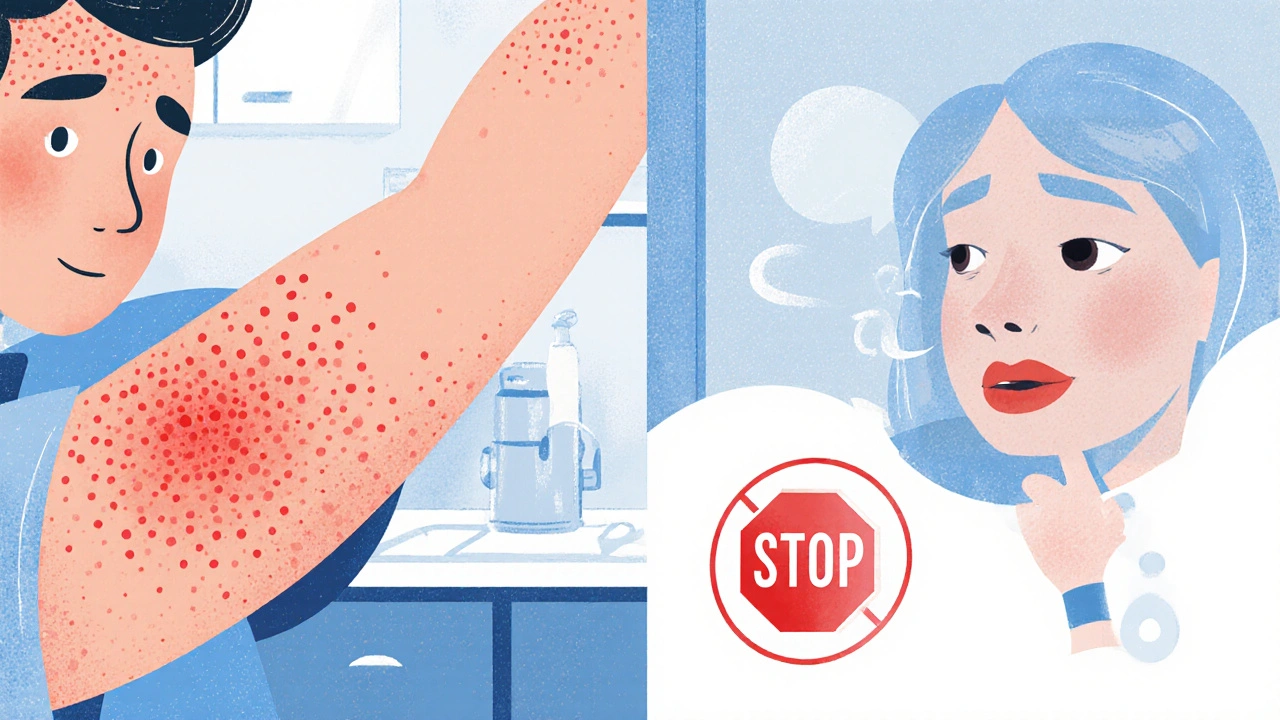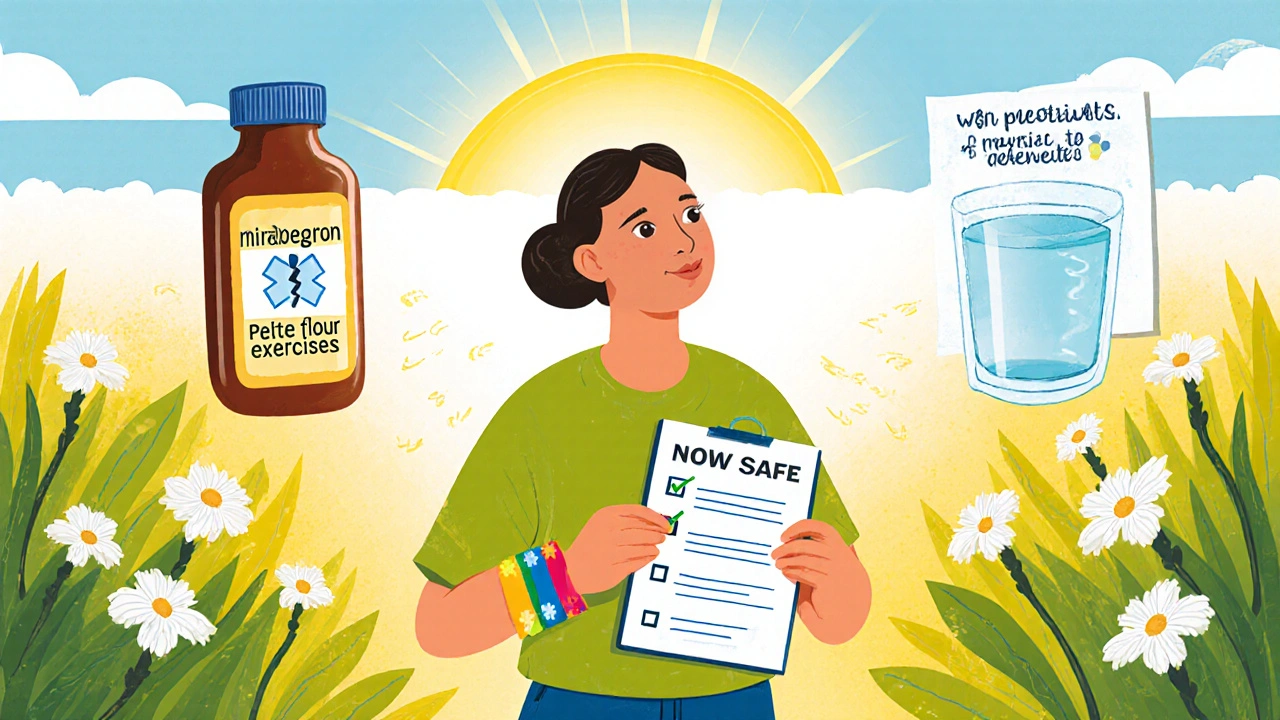Tolterodine Allergy Symptom Checker
This tool helps you determine if your symptoms may indicate a tolterodine allergic reaction. Based on your responses, it will provide guidance on the next steps.
Check Your Symptoms
Results
Check your symptoms to get guidance.
When you’re prescribed a medication for an overactive bladder, the last thing you want to worry about is an unexpected allergic reaction. tolterodine allergy may sound rare, but knowing the signs, risk factors, and what to do if it happens can keep you safe and confident about your treatment.
Quick Takeaways
- Tolterodine is an anticholinergic drug used to treat overactive bladder.
- Allergic reactions to tolterodine occur in less than 1% of users, but they can range from mild rash to severe anaphylaxis.
- Common symptoms include skin itching, hives, swelling, wheezing, and gastrointestinal upset.
- Higher risk groups include people with a history of drug hypersensitivity or existing mast cell disorders.
- If you suspect a reaction, stop the medication and seek medical help immediately; future treatment may involve alternative OAB drugs.
What Is Tolterodine?
Tolterodine is a prescription anticholinergic medication that relaxes the bladder muscle to reduce urgency and frequency. It is sold under brand names such as Detrol and Detrol‑LA and is approved in many countries for managing overactive bladder (OAB) symptoms.
How Does an Allergic Reaction to a Drug Work?
Allergic reaction is an immune‑mediated response where the body mistakenly identifies a harmless substance as a threat. When it comes to medications, the immune system can target the drug itself or a metabolite, triggering the release of histamine and other chemicals from mast cells. This release causes the classic symptoms of hypersensitivity.
How Common Are Allergic Reactions to Tolterodine?
Clinical trial data and post‑marketing surveillance suggest that true allergic reactions to tolterodine are reported in roughly 0.1%-0.5% of patients. While this is lower than the incidence for some antibiotics, the seriousness of a possible anaphylactic reaction means it cannot be dismissed.
| Medication | Incidence of hypersensitivity | Typical symptoms | Notes |
|---|---|---|---|
| Tolterodine | 0.1%-0.5% | Rash, itching, swelling, wheeze | Rare severe anaphylaxis |
| Oxybutynin | 0.2%-0.8% | Skin rash, dry mouth, dizziness | More anticholinergic side‑effects overall |
| Solifenacin | 0.1%-0.4% | Hives, facial swelling, GI upset | Cross‑reactivity with other anticholinergics is low |

Recognizing the Symptoms
Allergic reactions can appear within minutes or several hours after the first dose. Keep an eye out for these patterns:
- Skin: Red, itchy rash; raised hives (urticaria); swelling of lips, face, or tongue.
- Respiratory: Tightness in the throat, wheezing, shortness of breath, or a sudden cough.
- Cardiovascular: Light‑headedness, fainting, or rapid heartbeat.
- Gastrointestinal: Nausea, vomiting, abdominal cramping.
If you notice any of these after starting tolterodine, stop the drug immediately and seek medical attention. Even a mild rash can progress to a more serious reaction.
Who Is at Higher Risk?
While anyone can develop a drug allergy, certain factors raise the odds:
- Hypersensitivity history: Prior reactions to medications, especially other anticholinergics.
- Existing mast cell disorders such as mastocytosis.
- Concurrent use of multiple drugs that stimulate the immune system (e.g., some antibiotics).
- Genetic predisposition-certain HLA types have been linked to increased drug‑induced hypersensitivity.
What to Do If You Suspect an Allergy
- Stop the medication. Do not take another dose until cleared by a clinician.
- Call emergency services (911 or local equivalent) if you experience difficulty breathing, swelling of the throat, or a rapid drop in blood pressure.
- Document the reaction: note the time of onset, exact symptoms, and any other drugs taken.
- Visit a healthcare professional for evaluation. They may perform a skin prick test or in‑vitro IgE testing to confirm a tolterodine‑specific allergy.
- Wear a medical alert bracelet mentioning the drug allergy if the reaction was confirmed.
How Clinicians Confirm a Tolterodine Allergy
Doctors use a combination of clinical judgment and testing:
- History review: Detailed timeline of symptoms relative to medication start.
- Skin testing: Small amounts of the drug are placed on the skin to see if a wheal-and‑flare reaction occurs.
- Blood tests: Measurement of drug‑specific IgE antibodies (though not always available for tolterodine).
- Drug provocation test: In a controlled setting, a graded dose is given under supervision to observe any reaction-only performed if the diagnosis remains uncertain.
Because tolterodine is not a common allergen, many clinicians rely primarily on the patient’s symptom narrative and discontinue the drug as a precaution.

Alternative Treatments for Overactive Bladder
If you can’t tolerate tolterodine, several other options exist, each with its own risk profile:
- Oxybutynin: Another anticholinergic; slightly higher overall side‑effect burden but low cross‑reactivity.
- Solifenacin: Longer‑acting, often better tolerated, and minimal reported allergic events.
- Beta‑3 agonists (e.g., mirabegron): work via a different mechanism and are generally free of anticholinergic‑related allergies.
- Behavioral therapies: bladder training, pelvic floor muscle exercises, and fluid management can reduce reliance on medication.
Discuss with your urologist which alternative aligns with your health status and lifestyle.
Preventing Drug Allergies: Practical Tips
- Maintain an up‑to‑date medication list and share it with every new prescriber.
- Inform your pharmacist about any known drug allergies before filling a prescription.
- Ask about potential cross‑reactivity when switching between anticholinergic agents.
- Consider a trial dose under medical supervision if you have a strong history of drug hypersensitivity.
- Keep emergency antihistamines or an epinephrine auto‑injector handy if you have a history of severe reactions (consult your doctor first).
Key Takeaway Recap
Allergic reactions to tolterodine are rare but real. By recognizing early signs, knowing your personal risk factors, and having a clear action plan, you can stay safe while managing overactive bladder symptoms effectively.
Frequently Asked Questions
Can I develop an allergy to tolterodine after using it for years?
Yes. Drug allergies can appear after prolonged exposure, a phenomenon called delayed hypersensitivity. If new symptoms arise, stop the drug and seek evaluation.
Is a rash always a sign of an allergic reaction?
Not always. Some rashes are caused by the anticholinergic side‑effects (dry skin) rather than true allergy. Distinguish by looking for itching, swelling, or respiratory involvement, and consult your doctor.
Do I need an allergy test before trying another anticholinergic?
Routine testing isn’t required unless you had a severe reaction. Your doctor may opt for a cautious trial with close monitoring instead.
Can over‑the‑counter antihistamines treat a mild tolterodine allergy?
For mild skin itching or hives, an oral antihistamine can provide relief, but you should still discontinue the medication and discuss it with a clinician.
What should I tell emergency responders if I have an anaphylactic reaction?
State that you are experiencing an allergic reaction to tolterodine, mention any known drug allergies, and provide your medication list if possible. This helps them administer the correct emergency medication.

rama andika
Oh great, another “rare” drug allergy that the pharma‑bigwigs don’t want you to know about.
Kenny ANTOINE-EDOUARD
When you start a new medication, keeping a symptom diary is the single most effective step you can take. It lets you spot patterns that might otherwise be dismissed as unrelated. For tolterodine, note any skin changes, wheezing, or gastrointestinal upset within the first 24‑48 hours. If you notice a rash that spreads or trouble breathing, pause the drug and seek immediate care. Many clinicians will still recommend an alternative anticholinergic or a beta‑3 agonist after a brief washout period.
Jessica Wheeler
It’s ethically unacceptable for anyone to ignore a documented drug hypersensitivity just because it’s “rare.” Patients deserve transparency about even low‑probability risks. Documenting every reaction helps protect future selves and the broader medical community.
Sinead McArdle
Noted. Keeping a written record is indeed a practical safeguard.
Katherine Krucker Merkle
Adding to that, letting your pharmacist know about any allergy ensures they flag it before refilling any future prescriptions. A quick heads‑up can prevent a cascade of accidental exposures.
Mark Quintana
Cross‑reactivity among anticholinergics is thankfully low, but it’s still wise to perform a supervised test dose when switching drugs after a confirmed allergy. This approach minimizes anxiety and lets clinicians intervene should a reaction occur.
Brandon Cassidy
I agree; a supervised challenge provides concrete data rather than relying on speculation alone.